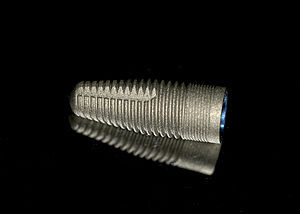Dental implants have become a central part of modern dentistry as they allow dentists to provide their patients with a comfortable, natural looking and highly functional alternative to restorations such as bridges and removable dentures. Implants provide individuals who have lost one or more teeth due to decay, an illness or an injury with the chance to live a normal life. They are a permanent solution, have success rates of 95%+ and improve the smile and confidence of everyone who gets them.
In order for an implant to successfully integrate with the jaw, the bone surrounding the restoration must be tall, wide and dense enough to support it. The bone must also be strong enough to endure the stresses that result from chewing food and the occasional accident. Bone loss can be caused by periodontal disease, trauma or an infection. Smokers, the elderly and those who have been missing a tooth or teeth for an extended period of time are more likely to have experienced considerable bone loss. In these cases, extra bone must be grafted to the jaw in order to create a strong foundation for a dental implant.
Types of Bone Material Used for Grafts
There are several sources of bone material that can used to build up the jawbone, ranging from the patient’s own bone material to artificial substitutes. The materials currently used in bone graft procedures include:
- The patient’s own bone
- Bone harvested from human cadavers
- Animal bone
- Mineral based synthetic bone
Patient Harvested Bone
Using the patient’s own bone is generally the safest and most effective choice for a bone graft. Bone is removed from another part of the body, typically the chin, jaw or hip and is transferred to the graft site. The primary advantage is that there is little chance of contracting an infection or disease from the bone graft. However, this does require an additional surgical procedure, resulting in increased expense and discomfort for the patient. Additionally, some illnesses may make the patient’s bone material unsuitable for use.
Cadaver Harvested Bone
Bone material taken from human cadavers is sterilized and freeze-dried at licensed tissue banks and distributed for use in bone grafts and other surgical procedures. Cadaver harvested bone is less expensive than bone taken from the patient’s own body. In addition, it eliminates the need for the patient to endure the surgery to harvest bone from their body.
However, using cadaver bone has an increased risk of being rejected by the body. While the Center for Disease Control (CDC) has very few reports of infection from the use of properly treated cadaver bone for dental implant grafts, this may still be a concern for some patients.
Animal Sourced Bone
Xenografts involve the use of tissue from another species. Cow bone is the most often used and is absorbed and replaced by the patient’s own bone over time. This method is less expensive, but also less successful than using bone taken from the patient or a cadaver.
As with bones from cadavers, care must be taken to ensure that the bone is properly sterilized before use. While the risk of infection is very small, it does exist. The graft can also be rejected and fail to integrate and be absorbed by the body. In that case, further medical treatment is required.
Artificial Bone-Like Materials
The use of synthetic material is becoming increasingly common. In addition to its lower cost, synthetic material eliminates any chance of infection. Similar to cow bone, synthetic material forms scaffolding for the patient’s bone to grow into, and is eventually absorbed by the body. However, this type of material does have a higher rate of failure than the alternatives.
Basic Procedure
Bone grafting is typically handled by a skilled oral surgeon. First, local anesthesia is applied to the donor and target sites. Small incisions are made over the target site and below the lower front teeth. A block of bone is removed from the chin and the incision is closed. After evaluation by the surgeon, the small block of bone is placed at the target site and is anchored to the surrounding bone with small titanium screws. After that, the surgeon will generally place a mixture of the patient’s bone marrow and other materials around the block of bone to assist with the integration process.
In most cases, a bone graft will take anywhere from six to nine months to become fully integrated with the jaw. During this period, the dentist will periodically evaluate the progress of the integration until it is complete. The dentist will then remove the titanium screws and proceed with the dental implant procedure.
The Cost of Dental Bone Grafts
The cost can vary widely, depending on the size and shape of the area receiving the graft, condition of the bone and type of bone graft material used. In most cases, a simple bone graft that makes use of human cadaver or cow bone will range in cost from $250 to $1,100. A graft that uses the patient’s own bone will be considerably more expensive due to the extra surgical procedures involved. The cost is usually around $2,000 to $3,000.
Bone grafting is an increasingly common procedure that makes it possible for individuals with bone loss to receive dental implants. Whether it is for a minor implant procedure or the replacement of most or all of the individual’s teeth, modern grafting has dramatically changed the field of implant dentistry.
[toggle title=”Featured images”]
[/toggle]


thank you, i clicked on adsense 😀